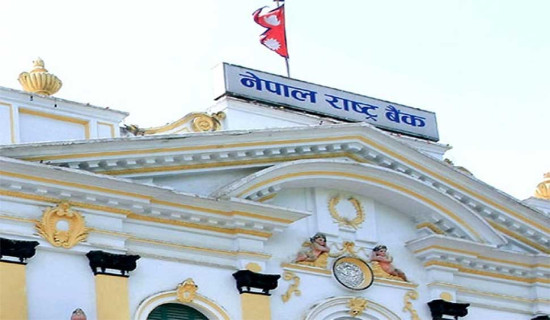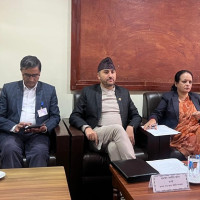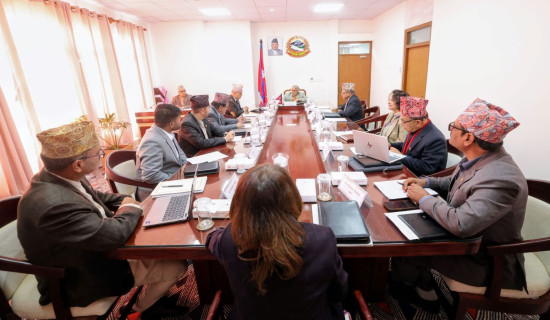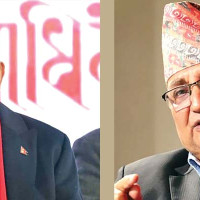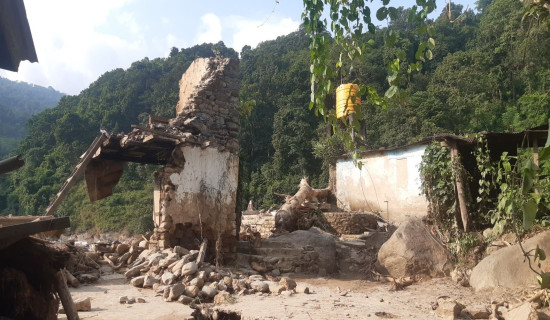- Tuesday, 16 December 2025
Mechanism Essential To Execute BRI Projects
During Prime Minister KP Sharma Oli's visit to China in November 2024, an agreement on the Belt and Road Initiative (BRI) framework was reached between Nepal and China. Under the framework, the Tokha-Chhahare Tunnel, Hilsa Simkot Road, Kimathanka-Khandbari Road and Bridge, China-Nepal Cross-Border Railway, Amargadhi City Hall, Geelong-Rasuwagadhi-Chilime Cross-Border Transmission Line, Madan Bhandari University of Science and Technology, Kathmandu Scientific Centre and Science Museum, China-Nepal Friendship Industrial Park, and Jhapa Sports and Athletics Complex have been included in the BRI framework.
Although Nepal officially signed a BRI agreement with China in 2017, its implementation has been sluggish. In 2019, the Nepali government presented 35 projects but only nine were incorporated into the BRI. In 2021, China presented the BRI Framework Implementation Plan to further guide the cooperation and implementation of the initiative with Nepal. After much debate and discussion, the BRI framework was eventually signed. The deal has instilled a new hope in the Nepali people to move forward on a new path of cooperation for development and progress.
New era of global trade
BRI is the modern version of the ancient Silk Road and aims to usher in a new era of global trade by investing significantly in infrastructure projects such as roads, railways, ports and bridges. It seeks to enhance people-to-people contacts and linkages between communities, nations, regions and belts worldwide, promoting mutual understanding and cooperation. The BRI has outlined five main objectives: infrastructure development, which aims to improve transport and energy systems; trade facilitation, which promotes multilateral trade and economic integration; financial investment and integration, which focuses on financial cooperation and a sustainable financial system; people-to-people ties to strengthen cultural exchanges, educational cooperation and tourism; and policy coordination, which aims to encourage the coordination of policies and development plans among participating countries.
The BRI has achieved significant achievements in the past 11 years since its inception. A total of 150 countries have joined the BRI. It covers about 75 per cent of the world's population. Under this ambitious initiative, around $1.4 trillion has been invested in various infrastructure and development projects and more than 3,000 projects have been signed. The countries participating in the BRI collectively account for more than 50 per cent of the world's GDP. In addition, the bilateral trade between them surpasses USD 5 trillion.
The BRI has become an important means of promoting trade, economic growth, greater connectivity and prosperity, especially in third-world countries. It stresses the establishment of new dimensions of global development by enhancing high-quality infrastructure for a more interconnected, dynamic and resilient global economy through collaborative efforts and strategic investments.
The international reaction to Nepal's BRI agreement reflects different perspectives and geopolitical considerations. Similarly, there was a serious political debate between the major political parties in Nepal from the beginning. Similarly, some leaders are adamant that they will not take out loans from China under any circumstances and will only accept grants. This type of thinking shows a lack of foresight for the long-term development of the country.
Nepal is borrowing a lot from Western countries and various international organisations, while the loan taken from China is negligible. There is no question of getting into a debt trap by borrowing from China. But we cannot just demand grants from any country in the world. Depending on the situation, different countries only look at bilateral interests and benefits. It is a pro-Western mindset to accept only grants from China but loans from Western countries on any terms. Since Nepal is a landlocked country, expanding connectivity in transport, communication, power transmission and developing agriculture and tourism by implementing projects under the BRI will be in Nepal's interest.
Lessons from past
Nepal should learn from past blockades and expand connectivity to the north. Nepal joined BRI based on the principles of sovereignty, independence and national interest. We have two big neighbours, which are developing rapidly. Since China is a large economy, receiving BRI projects from such a powerful partner is a significant opportunity for all countries, including Nepal. Nepal should make the most of the BRI loans based on its national needs and interests. When it comes to grants, partnerships, concessional loans and commercial loans, Nepal should be pragmatic. Only by adopting a balanced and forward-looking approach can Nepal harness the benefits of the BRI to achieve sustainable development and economic growth.
In view of frequent changes of governments and bureaucratic reshuffling, Nepal should form an autonomous, independent, and empowered BRI Development Authority involving professionals, technicians, and experts to implement the BRI projects. It should select, evaluate, implement, coordinate and monitor the BRI projects. Such authority will work on its own and remain unaffected by the change of governments. BRI holds the potential to give a new impetus to the country's development, especially for large-scale production, job creation and trade expansion. Thus, the creation of BRI Development Authority is expected to give momentum to the proposed BRI projects.
(The author is the president of the Confederation of Nepali Professionals (CONEP).



